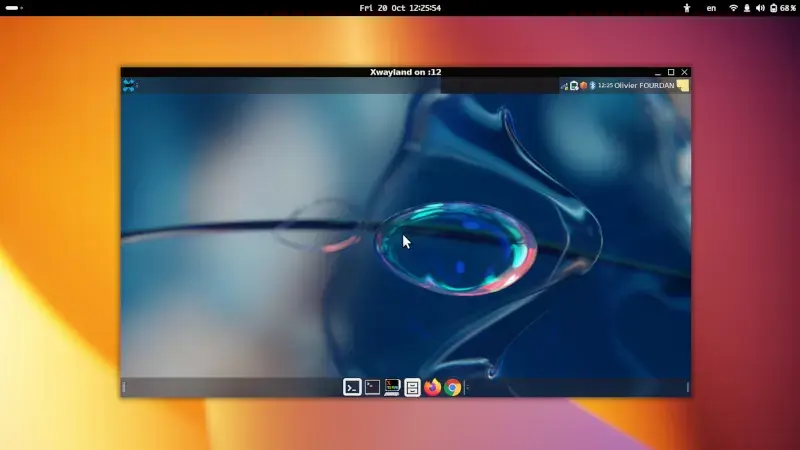XWayland 24.1 Released With Explicit Sync, Better Rootful Experience
XWayland 24.1 Released With Explicit Sync, Better Rootful Experience

XWayland 24.1 Released With Explicit Sync, Better Rootful Experience

XWayland 24.1 Released With Explicit Sync, Better Rootful Experience

XWayland 24.1 Released With Explicit Sync, Better Rootful Experience

I cannot wait until this lands in most distros. So much of the Wayland noise will go away.
what does "rootfull" mean?
XWayland normally runs x11 apps seamlessly (more or less) in Wayland
XWayland rootful spawns a window which is like a virtual monitor running a full x11 session inside it. You spawn apps inside of the window using the DISPLAY variable
Still, the Xwayland window is missing a title bar that would allow for moving the window around.
This is because Wayland does not decorate its surfaces, this is left to the Wayland client themselves to add window decorations (also known as client side decorations, or CSD for short).
This however would add a lot of complexity to Xwayland (which is primarily an Xserver, not a full fledged Wayland application). Thankfully, there is libdecor which can fence Xwayland from that complexity and provide window decorations for us.
This seems... ridiculous. Windows and MacOS developers don't worry about creating decorations. And they don't worry about that "adding a lot of complexity". Even with X11 you get decorations from the WM without any work. I know I don't understand the glory that is the Wayland architecture and that a bunch of folks will now angrily tell me all the numerous ways in which I'm not only wrong but but also stupid but.. It just seems weird is all.
Its confusing that we also use 'rootful' to refer to a process running as the root user
You need to wander through links a bit to find it but https://ofourdan.blogspot.com/2023/10/xwayland-rootful-part1.html talks about the rootful and the recent changes.
Sure. I can't wait to finally make the switch (Nvidia).
A compositor is a program responsible for displaying program windows and things like the desktop on your PC. On Linux, the compositor is just a program that starts when the system starts. There are multiple desktop environments available, like Plasma or Gnome, each comes with their own compositor, you can choose which you want to use.
Wayland is a protocol that the programs use to communicate with the compositor. Everyone decided to use Wayland, because if each compositor had their own protocol it would be silly, eg some programs would work only on Plasma or Gnome.
It's a replacement for a much older X11, which could no longer keep up with requirements of modern apps.
You never hear anything about compositors on Windows or Mac because there's only one available, you can't choose.
Actually, Windows does allow you to use an alternate “compositor”— a feature which is used quite frequently in the industrial/embedded space. Windows calls them “custom shells”. The default is Explorer, but it can be set to any executable.
https://learn.microsoft.com/en-us/windows/iot/iot-enterprise/customize/shell-launcher
It is being discussed because we're in the middle of the transition from X to Wayland. Before there wasn't much discussion. In a few years when it settles out there probably won't be much discussion.
Windows and Mac have never had a choice. There might have been significant changes to a window manager layer, but it would have been part of a larger version upgrade. Like between windows 3.1 and 95 or OS 9 to OS X. The visible changes would be closer to desktop environment like KDE and Gnome in Linux.
In addition to what the others have said, windows has already had its big paradigm change ("similar" to the change from x11 to Wayland that is happening) in the past. It was around 2007 with windows Vista. They also didn't get it quite right on the first try, but because Microsoft can do whatever they want, and in Linux you must convince the community that something is better, it was easier for them to just change everything under everyone's nose.
This is the best summary I could come up with:
Red Hat's Olivier Fourdan just announced the stable release of XWayland 24.1 as the newest feature release for this X.Org Server code allowing X11 clients to work within the confines of Wayland compositors.
XWayland 24.1 brings explicit sync support that's long been in the works throughout the stack.
The explicit sync support brings the most noticeable improvements for those using the NVIDIA proprietary Linux graphics driver with the R555 beta driver due out imminently with that driver-side support.
Also of NVIDIA relevance in XWayland 24.1 is removing the EGLStream back-end now that NVIDIA has finally been supporting GBM across their recent driver versions.
XWayland 24.1 also ships a number of rootful improvements including HiDPI and fractional scaling for the rootful mode, among other improvements.
The brief XWayland 24.1 release announcement can be found on the Xorg mailing list.
The original article contains 160 words, the summary contains 138 words. Saved 14%. I'm a bot and I'm open source!
Hopefully in Arch already
X11 is a mess. Wayland is a mess.
Solution: Create a new standard (always works so well)
I present x12land
Because fuck it!
Mir is there
If it would be a standard intented for Unix ideology and not business requirements of X11 (35+ years is a long time) or Wayland (RedHat is one company with its own interests, sometimes contradicting, say, mine as a Unix user), then it could work well.
X11 paradigm I like more than that of Wayland, but it could use some clearly incompatible changes.
xkcd 927
How, exactly, is Wayland a mess? It has a good legacy window compatibility layer and is solving a lot of problems X11 had. Seems perfectly alright to me.
Ehhh, any time I try a new distro I realize after a half dozen apps dont work, that its because its using wayland by default. X11 just works, wayland is a mess.